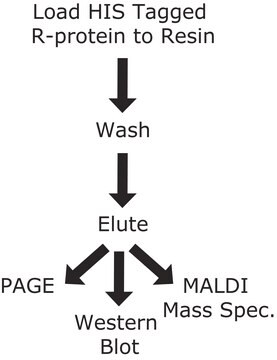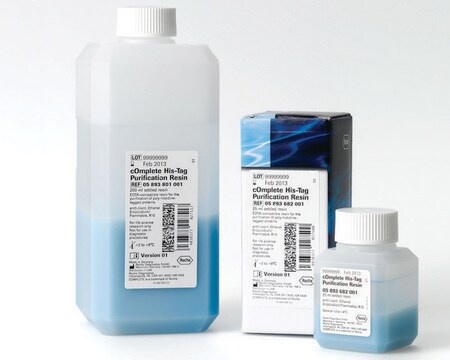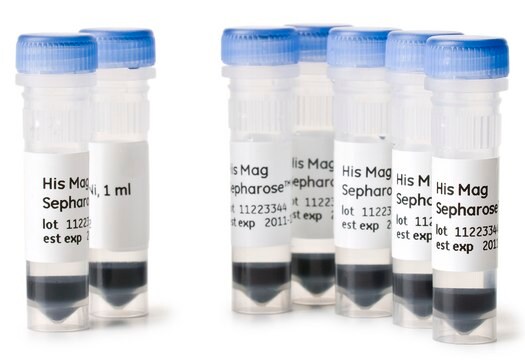A6861
Acetyl-CoA carboxylase 2 human
recombinant, expressed in Sf9 cells
Synonyme(s) :
ACACB, ACC2, acetyl-CoA carboxylase beta
Se connecterpour consulter vos tarifs contractuels et ceux de votre entreprise/organisme
About This Item
Produits recommandés
Application
Acetyl-CoA carboxylase is responsible for synthesis of Malonyl-CoA which is an inhibitor of fatty acid oxidation in skeletal muscle mitochondria. The enzyme may be used to study the effect on production of malonyl-CoA as well as fatty acid oxidation during exercise. The enzyme also may be used for ACC regulation study in anti-obesity and anti-type 2 diabetes therapeutics.
Actions biochimiques/physiologiques
Acetyl-CoA Carboxylase (ACC) regulates the metabolism of fatty acids. This enzyme catalzes the formation of Malonyl CoA through the irreversible carboxylation of acetyl CoA. There are two main isoforms of Acetyl-CoA carboxylase expressed in mammals, Acetyl-CoA carboxylase 1 (ACACA) and Acetyl-CoA carboxylase 2 (ACACB). ACACA has broad tissue distribution but is enriched in tissues critical for fatty acid sythesis such as adipose tissue. ACACB is enriched in tissues such as skeletal muscle and heart that are critical for fatty acid oxidation.
The Acetyl-CoA Carboxylase enzymes are activated by citrate, glutamate, and dicarboxylic acids and negatively regulated by long and short chain fatty acyl CoAs. Because of thier roles in fatty acid metabolism and oxidation, ACACA and ACACB are therapeutic targets for treating obesity and metabolic syndrome disorders.
The Acetyl-CoA Carboxylase enzymes are activated by citrate, glutamate, and dicarboxylic acids and negatively regulated by long and short chain fatty acyl CoAs. Because of thier roles in fatty acid metabolism and oxidation, ACACA and ACACB are therapeutic targets for treating obesity and metabolic syndrome disorders.
Propriétés physiques
C-terminal HIS-tagged 277 kDa full length protein
Définition de l'unité
One unit will cause the carboxylation of 1 picomole of acetyl-CoA per minute at pH 7.4 at 30 deg C.
Forme physique
Buffered aqueous solution containing Tris-HCl, pH 8.0, NaCl, glycerol, and DTT. May also contain one or more of the following: EDTA, KCl, imidazole, TWEEN-20.
Notes préparatoires
Thaw on ice. Upon first thaw, briefly spin tube containing enzyme to recover full content of the tube. Aliquot enzyme into single use aliquots. Store remaining undiluted enzyme in aliquots at -70°C. Note: Enzyme is very sensitive to freeze/thaw cycles.
Code de la classe de stockage
12 - Non Combustible Liquids
Classe de danger pour l'eau (WGK)
WGK 1
Point d'éclair (°F)
Not applicable
Point d'éclair (°C)
Not applicable
Certificats d'analyse (COA)
Recherchez un Certificats d'analyse (COA) en saisissant le numéro de lot du produit. Les numéros de lot figurent sur l'étiquette du produit après les mots "Lot" ou "Batch".
Déjà en possession de ce produit ?
Retrouvez la documentation relative aux produits que vous avez récemment achetés dans la Bibliothèque de documents.
W W Winder et al.
The American journal of physiology, 270(2 Pt 1), E299-E304 (1996-02-01)
Malonyl-CoA, an inhibitor of fatty acid oxidation in skeletal muscle mitochondria, decreases in rat skeletal muscle during exercise or in response to electrical stimulation. Regulation of rat skeletal muscle acetyl-CoA carboxylase (ACC), the enzyme that synthesizes malonyl-CoA, was studied in
Jorgen F P Wojtaszewski et al.
American journal of physiology. Endocrinology and metabolism, 284(4), E813-E822 (2002-12-19)
The metabolic role of 5'AMP-activated protein kinase (AMPK) in regulation of skeletal muscle metabolism in humans is unresolved. We measured isoform-specific AMPK activity and beta-acetyl-CoA carboxylase (ACCbeta) Ser(221) phosphorylation and substrate balance in skeletal muscle of eight athletes at rest
Lutfi Abu-Elheiga et al.
Proceedings of the National Academy of Sciences of the United States of America, 100(18), 10207-10212 (2003-08-16)
Malonyl-CoA, generated by acetyl-CoA carboxylases ACC1 and ACC2, is a key metabolite in the control of fatty acid synthesis and oxidation in response to dietary changes. ACC2 is associated to the mitochondria, and Acc2-/- mice have a normal lifespan and
Philip D Bates et al.
Proceedings of the National Academy of Sciences of the United States of America, 111(3), 1204-1209 (2014-01-09)
Degradation of unusual fatty acids through β-oxidation within transgenic plants has long been hypothesized as a major factor limiting the production of industrially useful unusual fatty acids in seed oils. Arabidopsis seeds expressing the castor fatty acid hydroxylase accumulate hydroxylated
Graeme J Gowans et al.
Cell metabolism, 18(4), 556-566 (2013-10-08)
While allosteric activation of AMPK is triggered only by AMP, binding of both ADP and AMP has been reported to promote phosphorylation and inhibit dephosphorylation at Thr172. Because cellular concentrations of ADP and ATP are higher than AMP, it has
Notre équipe de scientifiques dispose d'une expérience dans tous les secteurs de la recherche, notamment en sciences de la vie, science des matériaux, synthèse chimique, chromatographie, analyse et dans de nombreux autres domaines..
Contacter notre Service technique







